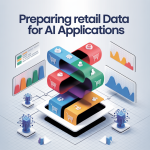
The Future of Retail: Navigating Digital Disruption Like a Pro
The retail industry is in the midst of a digital revolution.
E-commerce dominance, shifting consumer expectations, and rapid technological advancements are forcing retailers to rethink traditional models.
Those who fail to adapt risk falling behind, while forward-thinking businesses that embrace digital transformation are thriving.
In this article, we’ll explore advanced strategies, hidden gems, and expert insights to help retailers not just survive—but excel—in this era of digital disruption.
1. The Power of Data-Driven Retail: Making Smarter Decisions
Retailers sitting on mountains of consumer data often fail to harness its full potential.
Data is the key to predicting shopping behaviors, optimizing inventory, and personalizing customer experiences.
Advanced Strategies:
- Implement AI-powered predictive analytics to anticipate shopping trends and adjust inventory accordingly.
- Use real-time customer data to personalize marketing campaigns and offer relevant product recommendations.
- Adopt dynamic pricing algorithms to adjust prices based on demand, competitor pricing, and buying patterns.
Hidden Gem:
Retailers like Zara and H&M use fast-response data analytics to track which styles are trending, allowing them to adjust their production cycles in real time—giving them a competitive edge over traditional retailers.
2. Omnichannel Retailing: The Seamless Shopping Experience
Today’s shoppers expect a fluid shopping journey across multiple platforms—whether in-store, online, or via social media.
The key to success lies in creating an integrated and consistent experience across all channels.
Expert Insights:
- Implement Click-and-Collect (BOPIS) to combine online convenience with in-store pickup.
- Use geolocation technology to send personalized promotions to customers when they are near a store.
- Develop shoppable social media posts where customers can make purchases directly from platforms like Instagram and TikTok.
Hidden Gem:
Nike’s House of Innovation stores blend digital and physical retail, allowing customers to customize products in-store via digital touchpoints, scan QR codes for more details, and check out without waiting in line.
3. AI-Powered Personalization: The Key to Customer Loyalty
Consumers expect hyper-personalized shopping experiences, and AI is making it possible at scale.
Brands that utilize AI-driven personalization build stronger customer relationships and increase conversion rates.
Advanced Strategies:
- Use AI-powered chatbots and virtual assistants to provide real-time customer support and product recommendations.
- Implement facial recognition technology to identify repeat customers and offer customized in-store experiences.
- Offer AI-driven personalized promotions based on past purchases and browsing behavior.
Expert Insight:
Amazon’s AI-driven recommendation engine generates over 35% of its total sales, proving that personalized suggestions significantly impact revenue.
4. Contactless Shopping and the Cashierless Revolution
Since the pandemic, consumers have embraced contactless shopping, and retailers that provide frictionless experiences are seeing higher satisfaction and retention rates.
Hidden Gem:
- Amazon Go’s Just Walk Out technology eliminates checkout lines altogether—shoppers enter, grab what they need, and leave, with purchases automatically charged to their accounts.
Expert Insights:
- Implement RFID-enabled checkout systems for faster transactions.
- Offer QR code-based payments for a seamless, touch-free checkout process.
- Use mobile self-checkout apps to let customers scan and pay for items using their smartphones.
Contactless technology not only improves the shopping experience but also reduces labor costs and improves efficiency.
5. Augmented Reality (AR) and Virtual Reality (VR) for Interactive Shopping
Shoppers no longer need to visit stores to try products—AR and VR are transforming the way customers experience products before they buy.
Advanced Strategies:
- Use AR-powered apps to let customers visualize furniture, clothing, or makeup on themselves before purchasing.
- Create VR-based showrooms where customers can explore new collections in an immersive virtual space.
- Offer virtual try-on technology for fashion and beauty products.
Hidden Gem:
IKEA’s AR app lets customers preview how furniture will look in their homes before purchasing, significantly reducing product returns and increasing customer confidence.
6. Subscription-Based Retail: The Future of Customer Retention
One-time purchases are no longer enough—subscription-based models are helping brands build lasting customer relationships and predictable revenue streams.
Expert Insights:
- Offer exclusive VIP memberships with benefits like free shipping, early access to sales, and personalized product recommendations.
- Create subscription boxes tailored to customer preferences (e.g., Stitch Fix for fashion, HelloFresh for meal kits).
- Implement automated reordering systems for frequently purchased items like toiletries, groceries, and pet supplies.
Hidden Gem:
Sephora’s Beauty Insider loyalty program uses data to provide personalized product recommendations, birthday gifts, and exclusive offers, leading to higher customer retention.
7. Sustainability and Ethical Shopping: A Retail Imperative
Consumers today are increasingly making ethically conscious purchasing decisions.
Brands that incorporate sustainability into their business models are winning customer loyalty.
Advanced Strategies:
- Use recyclable and eco-friendly packaging to reduce environmental impact.
- Offer trade-in and upcycling programs for old products.
- Implement blockchain technology to provide full transparency into product sourcing.
Expert Insight:
Patagonia’s Worn Wear program encourages customers to trade in used clothing, repair old items, and buy secondhand gear—demonstrating a commitment to sustainability while fostering brand loyalty.
8. The Role of AI in Fraud Prevention and Security
With the rise of e-commerce and digital transactions, fraud has become a major concern for retailers.
AI is playing a crucial role in securing transactions and preventing fraud.
Expert Insights:
- Use AI-driven fraud detection to analyze transaction patterns and flag suspicious activity.
- Implement biometric authentication (fingerprint or facial recognition) for secure payments.
- Adopt blockchain technology to enhance payment security and transparency.
Hidden Gem:
Major retailers like Walmart and Alibaba are investing in blockchain-based supply chain tracking to prevent counterfeiting and fraud.
Final Thoughts
The retail industry is evolving faster than ever, and digital disruption is reshaping the way businesses operate. Retailers who embrace data-driven decision-making, AI-powered personalization, contactless shopping, omnichannel strategies, and sustainability will be the ones who thrive.
The future of retail isn’t just about selling products—it’s about creating an unforgettable, seamless, and customer-centric experience. Are you ready to lead the transformation? 🚀


